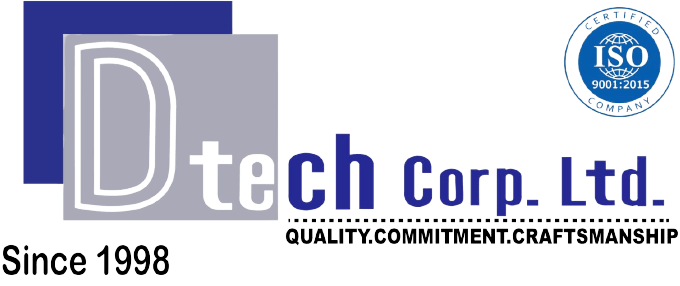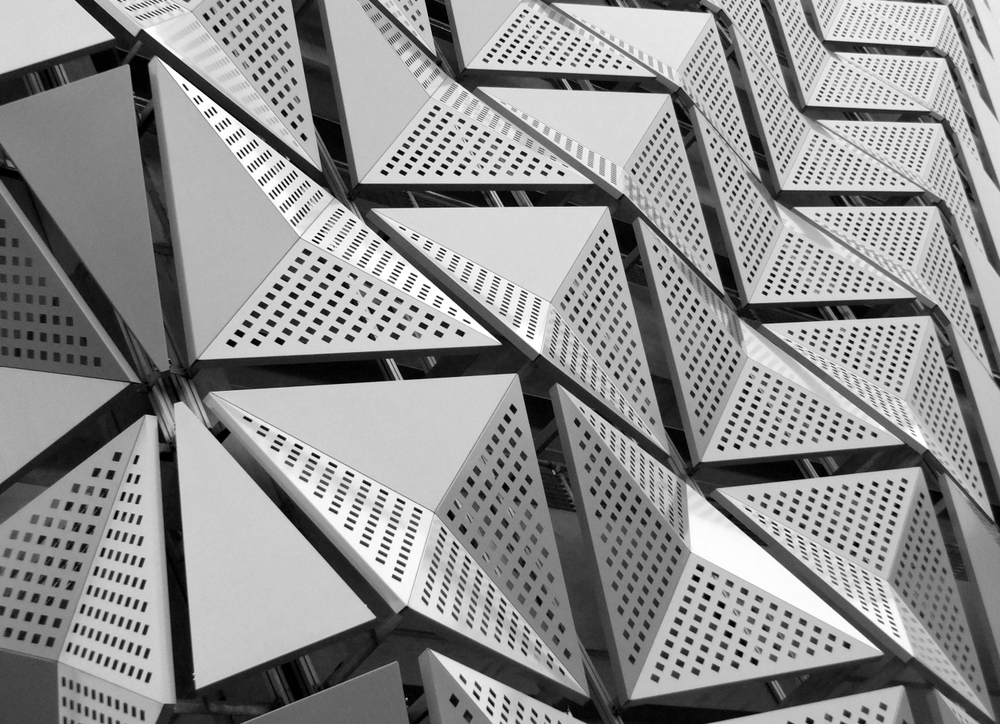What Are Perforated Facade Panels?
Perforated facade panels are architectural elements used in building construction to create visually appealing and functional exteriors. These panels are typically made from materials such as metal, wood, or composite materials and feature a series of holes or perforations in various patterns and sizes. The primary purpose of these panels is to enhance the aesthetic appeal of a building while also providing functional benefits like ventilation, light filtration, and acoustic control.
Key Features of Perforated Facade Panels
- Aesthetic Versatility: Perforated facade panels are available in a variety of designs, materials, and finishes, allowing them to match diverse architectural styles. Architects can choose from an array of patterns and perforation sizes to achieve the desired visual impact, from intricate, decorative designs to simple, functional patterns.
- Functionality: Beyond their aesthetic appeal, perforated facade panels offer numerous functional benefits. They improve ventilation by allowing air to circulate through the perforations, contribute to natural lighting by filtering sunlight, and help manage acoustics by reducing noise levels within the building. These functionalities make perforated panels a versatile solution for modern building design.
- Durability: Perforated facade panels are made from robust materials such as aluminum, steel, and high-pressure laminates, ensuring they withstand various weather conditions and maintain their structural integrity over time. The choice of material impacts the panel’s resistance to corrosion, mechanical wear, and environmental stressors.
- Customization: One of the standout features of perforated facade panels is their high degree of customization. Architects and designers can tailor the size, shape, and pattern of the perforations to meet specific design requirements and functional needs. This flexibility allows for unique and personalized building facades that can reflect the architectural vision and brand identity.
Why Use Perforated Facade Panels?
Benefits of Perforated Facade Panels
- Enhanced Aesthetics: Perforated facade panels provide a unique and modern look, allowing architects to create intricate designs and patterns on building exteriors. The ability to manipulate light and shadow through the perforations adds a dynamic element to the building’s appearance, making it more visually engaging.
- Natural Light Management: The perforations in the panels allow natural light to filter through, reducing the need for artificial lighting and enhancing the interior ambiance. This natural light penetration not only creates a pleasant and well-lit indoor environment but also contributes to energy savings by lowering the reliance on electrical lighting.
- Ventilation: By improving air circulation within the building, perforated facade panels contribute to a healthier indoor environment. Proper ventilation helps maintain air quality, regulate temperature, and prevent the buildup of moisture and pollutants, enhancing the overall comfort and well-being of the occupants.
- Energy Efficiency: Perforated facade panels help in regulating building temperature by reducing heat gain. This passive cooling effect lowers the energy consumption required for air conditioning, making the building more energy-efficient. Additionally, the panels can be designed to provide shading, further contributing to temperature control.
- Acoustic Control: Perforated panels can reduce external noise, making the interior spaces quieter and more comfortable. The perforations act as sound diffusers, mitigating the impact of environmental noise and improving the acoustic quality of indoor spaces.
Applications of Perforated Facade Panels
- Commercial Buildings: In office buildings, shopping malls, and hotels, perforated facade panels are used to create eye-catching facades that stand out in urban landscapes. They can be designed to align with corporate branding, enhance the building’s identity, and attract visitors and clients.
- Residential Structures: Perforated panels enhance the curb appeal of apartment complexes and houses by adding a modern and sophisticated touch. They can be used for privacy screens, balcony enclosures, and decorative elements that improve the overall aesthetic of residential properties.
- Public Infrastructure: Perforated facade panels are applied in transportation hubs, sports facilities, and educational institutions for both functional and decorative purposes. In these settings, they contribute to environmental comfort, energy efficiency, and aesthetic value, enhancing the user experience.
How to Choose the Right Perforated Facade Panels
Factors to Consider
- Material: Selecting the appropriate material for perforated facade panels is crucial to ensuring they complement the building’s architecture and meet durability requirements. Common materials include aluminum, steel, and high-pressure laminates, each offering unique benefits in terms of strength, weight, and aesthetic possibilities.
- Perforation Pattern: The pattern of perforations should align with the design vision and functional needs of the project. Options include circular, square, hexagonal, and custom shapes, each creating different visual effects and levels of transparency and ventilation.
- Finish: The finish of the panels affects both their appearance and longevity. Options such as powder coating, anodizing, and painting provide different levels of protection against corrosion, UV radiation, and mechanical wear. Choosing the right finish ensures that the panels maintain their aesthetic appeal and performance over time.
- Installation Method: Evaluating the installation process and compatibility with existing building structures is essential for the successful implementation of perforated facade panels. Factors to consider include the panel’s attachment method, structural support requirements, and potential impact on the building envelope.
Maintenance of Perforated Facade Panels
Regular maintenance is essential to preserve the appearance and functionality of perforated facade panels. Maintenance tasks include:
- Periodic Cleaning: Removing dirt, dust, and debris from the panels to prevent buildup that can affect their appearance and performance. Cleaning methods should be appropriate for the material and finish to avoid damage.
- Inspection for Damage: Regularly inspecting the panels for signs of damage, such as dents, corrosion, or loose attachments. Early detection and repair of issues can prevent more significant problems and extend the panels’ lifespan.
- Repairs and Replacements: Performing necessary repairs or replacements promptly to maintain the integrity and aesthetics of the facade. This includes addressing any structural issues, replacing damaged panels, and restoring finishes as needed.
FAQs About Perforated Facade Panels
What are the common materials used for perforated facade panels?
Common materials for perforated facade panels include aluminum, steel, stainless steel, and high-pressure laminates. Each material offers unique benefits:
- Aluminum: Lightweight, corrosion-resistant, and highly versatile in terms of design and finish options.
- Steel: Provides superior strength and durability, suitable for high-impact applications.
- Stainless Steel: Offers excellent corrosion resistance and a sleek, modern appearance.
- High-Pressure Laminates: Combine durability with a wide range of aesthetic finishes, suitable for both interior and exterior applications.
Can perforated facade panels be used for both new constructions and renovations?
Yes, perforated facade panels are versatile and can be integrated into both new constructions and renovation projects. In new constructions, they can be incorporated into the design from the outset, enhancing the building’s exterior. In renovation projects, they can be added to existing structures to update and modernize their appearance while providing additional functional benefits.
How do perforated facade panels contribute to energy efficiency?
Perforated facade panels contribute to energy efficiency by:
- Allowing Natural Light Penetration: Reducing the need for artificial lighting and lowering energy consumption.
- Improving Ventilation: Enhancing air circulation, which can reduce the reliance on HVAC systems for temperature control.
- Providing Shading: Minimizing solar heat gain and reducing the load on cooling systems, leading to lower energy costs.
Are perforated facade panels customizable?
Yes, perforated facade panels can be customized in terms of material, perforation pattern, size, and finish to meet specific design and functional requirements. This customization allows architects to create unique and tailored solutions that reflect the project’s aesthetic and performance goals.
What is the lifespan of perforated facade panels?
The lifespan of perforated facade panels varies depending on the material and environmental conditions. High-quality panels made from durable materials such as aluminum, steel, or stainless steel can last for several decades with proper maintenance. Factors that influence lifespan include exposure to weather, maintenance practices, and the quality of the installation.
Conclusion
Perforated facade panels offer a blend of aesthetic appeal and functional benefits, making them an excellent choice for modern architectural designs. Whether used in commercial, residential, or public buildings, these panels enhance the visual interest and performance of structures. By understanding their features, benefits, and maintenance requirements, architects and builders can effectively incorporate perforated facade panels into their projects for improved aesthetics and functionality.
Integration of Perforated Facade Panels in Modern Architecture
The integration of perforated facade panels in modern architecture represents a shift towards designs that prioritize both form and function. These panels enable architects to push the boundaries of creativity, creating visually stunning buildings that also meet practical needs such as energy efficiency, ventilation, and acoustic control. The adaptability of perforated panels means they can be used in a variety of settings, from urban skyscrapers to suburban homes, contributing to the diverse landscape of contemporary architecture.
Future Trends in Perforated Facade Panels
As technology and materials science continue to advance, the future of perforated facade panels looks promising. Innovations such as smart materials, integrated lighting systems, and advanced manufacturing techniques are set to expand the possibilities for perforated panels. These developments will enable even greater customization, sustainability, and functionality, cementing the role of perforated facade panels as a key element in the evolution of architectural design.
In summary, perforated facade panels are a versatile and valuable component of modern architecture. Their ability to enhance aesthetics, improve energy efficiency, and provide functional benefits makes them an attractive choice for a wide range of building projects. By staying informed about the latest trends and technologies, architects and builders can leverage perforated facade panels to create buildings that are not only beautiful but also highly functional and sustainable.


Leave a Reply